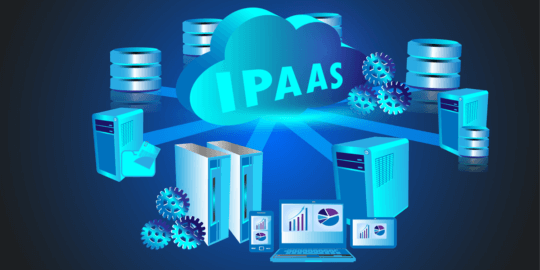Why do you need iPaaS? – And Not Simply a Cloud?

Choosing the right integration platform is an important decision for your company. Many different requirements and effects have to be considered. These include internal and external costs, existing in-house know-how and human resources as well as the requirements for technology, service levels and functions such as 24/7 operation or the ability to intervene in a service.
In addition to these obvious selection criteria, the integration platform must also be evaluated in the context of existing and deployed solutions in your company, as well as the desired improvements. Do you currently operate one or more existing solutions locally yourself? Do you use cloud offers or the service of a VAN operator? Within the cloud offerings, there are various operating models and commercial offerings. Which one is best suited to your company?
A commonly quoted keyword in this context is iPaaS or Integration Platform as a Service. This is a cloud-based operating model whose characteristics can be flexibly adapted to the above-mentioned requirements and selection criteria and can solve a wide range of integration requirements. Find out why you should take a closer look at iPaaS.
Quite simply because: if you need to react quickly and highly flexibly to business requirements with few staff, you should rather focus on your core business than on operating other peoples’ integration software.
What exactly is iPaaS? According to the common definition, iPaaS is a finely tuned set of cloud services that enable the development, execution and control of integration flows by connecting any local and cloud-based processes, services, applications and data within or between enterprises.
This sounds quite simple, but the implementation is a great challenge. After all, iPaaS must be able to handle all integration requirements regardless of the use case.
Why do you need iPaaS? Here are 4 good reasons why iPaaS is exactly the right solution for this task:
1) iPaaS increases investment security
There are two different approaches to solving the integration problem. You can look at each integration task separately and try to solve the task as pragmatically as possible by using the first available or randomly known tool. This is the typical approach of business departments that only have their current integration task in mind, but not the integrative overall view that the IT department needs to have. However, this inevitably leads to a very complex environment, at the expense of security and efficiency.
Alternatively you can take a holistic approach right from the outset and rely on a central integration platform to solve the integration problem. Of course, this approach will only be successful if it does not slow down the progress of the departments too much. This is precisely where the strength of cloud-based iPaaS solutions lay, with their easy configurability. An iPaaS solution makes application integration quick and easy to orchestrate, so that your business departments are involved in the integration process from the start and can keep the reins in their own hands.
In the long run, this leads to more motivated employees and a future-proof, centralized integration approach. In short: iPaaS increases investment security.
2) iPaaS allows maintainability
Numerous partner backend or cloud applications to be connected bring their own integration interfaces. Decentralized integration of such applications inevitably leads to uncontrollable proliferation, which can hardly be maintained and is very difficult to secure.
By consolidating all integration tasks on a single platform, your integration teams become much more efficient. Security requirements can be implemented much more easily and are also controllable and certifiable. NB: The best possible service levels can be realized on a central platform.
3) iPaaS enables business continuity
If all integration processes in a company are handled centrally via one platform, this platform and its operation is critical to the company. Therefore, the platform must be operated with the highest possible availability and reliability. The danger of cyber-attacks must be countered with maximum security precautions. Cloud providers in particular have proven in the past that they can offer far more in terms of availability, reliability and security than a company can usually provide on its own. With a cloud-based iPaaS solution, you ensure that business continuity is always guaranteed in your company.
4) iPaaS meets hybrid integration requirements
Whether API interfaces or classic MFT and B2B requirements – with a hybrid integration platform all these demands can be met and even your locally operated existing solutions can be seamlessly integrated. Regardless of the integration scenarios ground-to-cloud, cloud-to-cloud or ground-to-ground, both transaction-based real-time requirements and file-based processes can be mapped. An iPaaS solution helps you to connect the cloud worlds profitably.
Why do you need iPaaS? Here is our conclusion:
A cloud-based integration platform like iPaaS offers you the greatest possible flexibility to meet all your technology and service level requirements. It allows you to seamlessly integrate even your locally operated legacy solutions so that you can enjoy the benefits of both worlds.
iPaaS solves all your integration needs
The multitude of formats, protocols and the very different connected endpoints require a powerful platform that ensures the maintainability of the orchestrated integration processes and enables central monitoring of all data flows. In spite of the diverse requirements, the agility of your business as well as know-how and flexibility remain within the company. With iPaaS, a fast response to customer requirements is guaranteed.
The most important advantage of iPaaS in business:
The iPaaS model combines the advantages of a cloud application, which by its very nature provides all the functionality and the required performance and security features, with the flexibility of a self-operated application that allows you to act quickly and freely.
The SEEBURGER iPaaS solution
The iPaaS solution from SEEBURGER addresses precisely these challenges. SEEBURGER’s iPaaS solution is based on a hybrid integration platform that combines all required protocols, formats and technologies in a single product. The core requirements for an iPaaS service are:
- Uniform communication platform
- Conversion of all formats with one tool
- Central monitoring
- Orchestration of processes and access rights
- Preconfigured processes for recurring integration tasks
With the iPaaS service from SEEBURGER, even very complex, business-critical and extensive integration requirements can be realized. By using a central integration platform, costs can be planned over the life cycle of an integration task.
Thank you for your message
We appreciate your interest in SEEBURGER
Get in contact with us:
Please enter details about your project in the message section so we can direct your inquiry to the right consultant.
Written by: Holger Fiederling
Holger Fiederling has been working for SEEBURGER since 2008 and initially worked as a product manager for SEEBURGER B2B-Solutions. Since 2014, he has been responsible for pre-sales and business development for the SEEBURGER Cloud. His focus is on the creation of new, innovative solutions and services, which are oriented towards the requirements of the customers, always with the aim of maximizing the latest opportunities for the customers. In doing so, he attaches great importance to taking into account the experience gained from all of his international customer projects. After starting his career in the automotive industry, Holger Fiederling worked for two large management consultancies in the SAP environment and in the area of hosting and outsourcing of IT processes. To compensate for this, he spends a lot of time on his mountain bike or skiing in winter.





